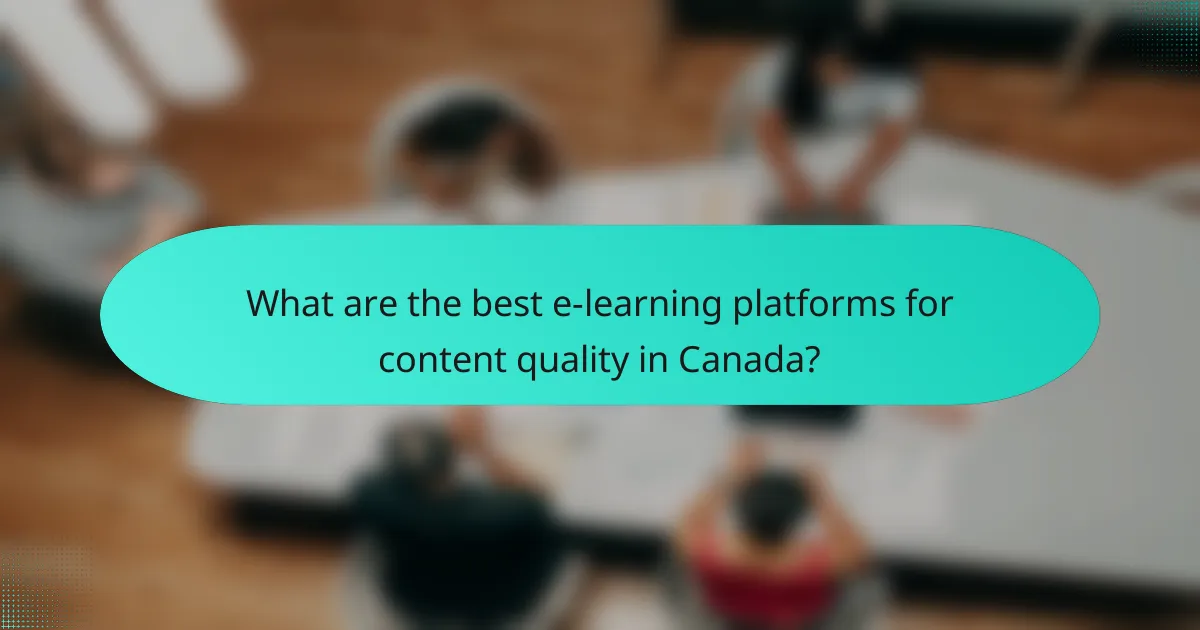E-learning platforms have become essential for modern education, with top providers like Coursera, Udemy, and LinkedIn Learning setting high standards for content quality. However, these platforms face challenges in user engagement and technical performance, which can impact the overall learning experience. By addressing issues such as scalability and integration with Learning Management Systems, they can enhance user satisfaction and foster a more interactive learning environment.

What are the best e-learning platforms for content quality in Canada?
The best e-learning platforms for content quality in Canada include Coursera, Udemy, and LinkedIn Learning. These platforms are recognized for their rigorous content standards, user engagement, and effective course review mechanisms.
Coursera content quality standards
Coursera maintains high content quality standards by partnering with top universities and organizations. Courses are designed by experts and often include peer-reviewed assignments and quizzes to ensure comprehension.
Additionally, Coursera employs a review process where courses are evaluated based on learner feedback and completion rates. This helps to continuously improve course offerings and maintain a high standard of education.
Udemy course review mechanisms
Udemy utilizes a robust course review system that allows students to rate and provide feedback on courses. This feedback is crucial for potential learners as it helps them gauge the quality and relevance of the content.
Instructors are encouraged to respond to reviews, which fosters engagement and can lead to course improvements. Udemy also offers a money-back guarantee, which adds an extra layer of assurance for learners regarding content quality.
LinkedIn Learning content curation
LinkedIn Learning focuses on content curation by selecting courses that align with industry trends and skills in demand. Their platform features courses created by industry professionals, ensuring that the content is both relevant and practical.
Moreover, LinkedIn Learning regularly updates its course library based on user interests and job market needs, which helps learners stay current with the skills required in their fields. This approach enhances the overall quality of the learning experience.

How can user engagement be improved on e-learning platforms?
User engagement on e-learning platforms can be significantly enhanced through various strategies that foster interaction and motivation. By implementing gamification, interactive content, and community building techniques, platforms can create a more immersive and appealing learning environment.
Gamification strategies
Gamification involves integrating game-like elements into the learning experience to boost motivation and engagement. This can include points, badges, leaderboards, and challenges that reward learners for completing tasks or achieving milestones.
For effective gamification, consider setting clear objectives and providing immediate feedback. A well-structured points system can encourage competition, while badges can serve as recognition of accomplishments. Ensure that the challenges are appropriately difficult to maintain interest without causing frustration.
Interactive content features
Interactive content features, such as quizzes, simulations, and drag-and-drop activities, can significantly enhance user engagement. These elements allow learners to actively participate rather than passively consume information, leading to better retention and understanding.
Incorporate multimedia elements like videos and animations to make the content more dynamic. Regularly update these features to keep the material fresh and relevant, and consider using adaptive learning technologies that tailor the experience based on individual learner performance.
Community building techniques
Building a community around an e-learning platform can foster a sense of belonging and encourage collaboration among learners. Techniques include discussion forums, group projects, and social media integration, which allow users to share experiences and support one another.
Encourage regular interaction through scheduled live sessions or webinars where learners can engage directly with instructors and peers. Establishing mentorship programs can also enhance community ties, providing learners with guidance and support from more experienced individuals.

What technical challenges do e-learning platforms face?
E-learning platforms encounter various technical challenges that can hinder their effectiveness and user experience. Key issues include scalability, integration with existing Learning Management Systems (LMS), and mobile accessibility, each requiring careful consideration to ensure smooth operation and user satisfaction.
Scalability issues
Scalability is a critical challenge for e-learning platforms, especially as user numbers grow. Platforms must be able to handle increased traffic without compromising performance, which often requires robust server infrastructure and efficient load balancing.
For example, during peak usage times, such as the start of a new semester, platforms should maintain response times in the low tens of milliseconds. Investing in cloud services can help manage scalability effectively, allowing for on-demand resource allocation.
Integration with Learning Management Systems
Integrating e-learning platforms with existing Learning Management Systems (LMS) can be complex and time-consuming. Compatibility issues may arise, requiring developers to ensure that data flows seamlessly between systems.
Consider using widely adopted standards like SCORM or xAPI for better integration. This can help streamline the process and reduce the likelihood of data silos, ensuring that user progress and performance metrics are accurately tracked across platforms.
Mobile accessibility problems
Mobile accessibility is essential for e-learning platforms, as many users prefer learning on their smartphones or tablets. However, not all platforms are optimized for mobile use, leading to usability issues.
To enhance mobile accessibility, platforms should prioritize responsive design and ensure that all features are functional on smaller screens. Testing on various devices and screen sizes can help identify and resolve potential issues, improving the overall user experience.

What criteria should be considered when choosing an e-learning platform?
When selecting an e-learning platform, consider factors such as content quality, user engagement metrics, and technical support availability. These criteria will help ensure that the platform meets educational goals and provides a positive learning experience.
Content quality evaluation
Content quality is crucial for effective learning. Look for platforms that offer well-structured courses, engaging materials, and up-to-date information. Check if the content aligns with recognized educational standards or industry certifications.
Consider user reviews and ratings to gauge the effectiveness of the content. Platforms that provide sample lessons or trial periods can help you assess the quality before committing.
User engagement metrics
User engagement metrics indicate how actively learners participate in the courses. Key metrics include course completion rates, time spent on tasks, and interaction levels with quizzes and discussions. High engagement often correlates with better learning outcomes.
Platforms that offer analytics dashboards can provide insights into these metrics, allowing you to track progress and identify areas needing improvement. Look for features like gamification or social learning tools that enhance user interaction.
Technical support availability
Reliable technical support is essential for resolving issues quickly and minimizing disruptions. Check if the platform offers 24/7 support, multiple contact methods (like chat, email, or phone), and a comprehensive knowledge base.
Evaluate the responsiveness of the support team through reviews or by testing their response times during the trial phase. A platform with robust technical support can significantly enhance the overall user experience.

How do e-learning platforms compare in user engagement?
User engagement on e-learning platforms varies significantly based on content delivery, interactivity, and community features. Understanding these differences can help learners choose the right platform for their needs.
Coursera vs. Udemy engagement rates
Coursera typically boasts higher engagement rates compared to Udemy, largely due to its structured courses and partnerships with universities. Learners on Coursera often participate in peer-reviewed assignments and discussion forums, which enhance interaction.
In contrast, Udemy offers a more flexible learning experience with a vast array of courses. While this flexibility can attract a wide audience, it may lead to lower engagement as learners might not feel compelled to complete courses without a structured framework.
LinkedIn Learning vs. Skillshare user interaction
LinkedIn Learning emphasizes professional development, which encourages higher user interaction through personalized course recommendations and integration with LinkedIn profiles. Users often engage with courses that align with their career goals, fostering a more committed learning environment.
Skillshare, on the other hand, focuses on creative skills and community-driven learning. Users can interact through project sharing and feedback, but the engagement may vary widely based on individual course popularity and community activity levels.

What are the emerging trends in e-learning platforms?
Emerging trends in e-learning platforms focus on enhancing user experience and learning outcomes through innovative technologies. Key developments include the integration of artificial intelligence, virtual reality, and microlearning strategies to create more personalized and engaging educational experiences.
Artificial intelligence in personalized learning
Artificial intelligence (AI) is transforming personalized learning by adapting content to meet individual learner needs. AI algorithms analyze user behavior and performance data to tailor educational materials, ensuring that learners receive relevant resources and feedback.
For instance, platforms can use AI to recommend courses based on a learner’s previous interactions or suggest specific modules that address knowledge gaps. This customization can significantly enhance engagement and retention rates.
Virtual reality applications in education
Virtual reality (VR) applications in education provide immersive experiences that can enhance understanding and retention of complex subjects. By simulating real-world environments, VR allows learners to engage in hands-on activities that would be difficult or impossible in a traditional classroom setting.
Examples include virtual labs for science experiments or historical simulations for social studies. Such interactive experiences can lead to deeper learning and greater enthusiasm for the subject matter.
Microlearning for skill acquisition
Microlearning focuses on delivering content in small, easily digestible segments, making it ideal for skill acquisition. This approach allows learners to engage with material in short bursts, which can fit into busy schedules and improve retention.
Effective microlearning can include brief video tutorials, quizzes, or infographics that target specific skills. This method encourages continuous learning and can be particularly beneficial in fast-paced industries where skills need to be updated frequently.
